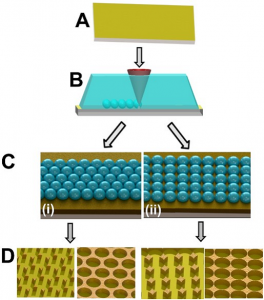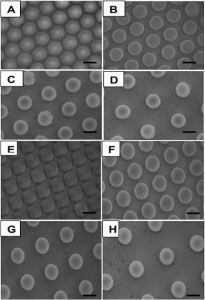Metallic architectures with nanoscale features are in high demand because of their unique electrical and optical properties, but aren’t the easiest to fabricate…unless 3D printing comes into play, of course. A collaborative team of Irish researchers from Trinity College Dublin, Dublin City University, and the Coombe Women & Infants University Hospital published a paper, titled “Tunable metallic nanostructures using 3D printed nanosphere templates,” about their use of two-photon polymerization to create polymer spheres. The researchers can easily control the pitch, size, and “packing” of the spheres at the sub-micrometer scale, and can then create metallic nanostructures like gold nanodiamonds by electrodepositing gold through a template.
Fabrication of a periodic particle array. (A) Gold-coated silicone wafer, (B) photoresist on gold electrode and 3D laser polymerization of photoresist, (C) nanosphere arrays 3D printed on the electrode after electroplating (i) hexagonal close packing of spheres and (ii) square close packing of spheres, (D) periodic nanostructured metal arrays after removal of the polymer templates.
The abstract reads, “The use of two-photon 3D printing to create templates for fabricating reproducible and tunable metallic nanostructures is described. The approach allows the structure of the template to be designed specifically for particular applications, e.g., fluid flow control, surface enhanced Raman spectroscopy, metal enhanced fluorescence etc. Here, we show that this method offers excellent control of the size, pitch and packing of spheres on both conducting and insulating substrates, unlike nanosphere lithography. Gold is deposited through these templates and the template then removed using a plasma etching method. In this way, gold nanotriangles, nanodiamonds and nanocavities have been created and characterized using SEM to determine the accuracy of the structures compared to the software designs.”
Two-photon direct laser writing allows for the creation of 3D nano-features with optical quality surface finishes, which in turn makes it possible to create nanoscale templates that researchers can deposit metals through so the nanostructure’s properties are controlled by the architecture and material composition.
“This combination leads to important electronic and photonic properties as well as applications in life sciences such as the high efficiency capture of rare cells,” the researchers state.
The team used a femtosecond laser lithography 3D printer from Nanoscribe GmbH to fabricate 3D templates, and then carried out the electrodeposition of gold.
“A gold film of controlled thickness was electrochemically deposited through the printed template from a commercial aqueous gold plating solution,” the researchers explained. “After deposition, the gold-printed template was treated with an oxygen plasma (Oxford Instruments RIE) at a power and pressure of 100 W and 100 mTorr, respectively, for a duration of 30 min, to remove the printed sphere template. The structure and morphology of the printed polymer sphere template and the resulting nanostructures were investigated using a Hitachi S-3000 N scanning electron microscope.”
Typical nanosphere lithography just won’t cut it when it comes to controlling template dimensions, packing arrangements, and inter-sphere separation with two-photon polymerization for many reasons, which is why the team relied on 3D printed templates.
“The size of the nanoscale features can be controlled by specifying the diameter of the spheres, which can be done while drawing the structures,” the researchers wrote. “The thickness of the metal structures can be controlled during the electroplating step.”
The fact that the team was able to produce a square lattice is a big deal, as hexagonal sphere packing is usually more stable. Software was used to analyze the SEM images, and the results show that homogeneous spheres “with ±10 nm variation in diameter after printing” can be achieved in this method. Additionally spin-coating and baking of the photoresist isn’t necessary, which saves time, and the 3D printing occurs under ambient conditions.
“This method makes it possible to produce spheres at different packing densities in a controlled way, which is challenging in nanosphere lithography. Moreover, this technique is cheaper than complex systems for writing nanoscale features such as e-beam lithography,” the researchers explained.
The researchers learned some interesting things, such as how they could use nanosphere writing lithography to control the distance between nanotriangles’ sharp edges, and that they can control the thickness of the nanoscale features “through the charge passed during the electrodeposition cycle.”
“We believe that this is the first demonstration of the fabrication of a diamond array using the direct laser writing technique coupled with electrodeposition,” the researchers concluded.
“The main advantage of this printing technology is that any pattern can be produced on a non-conductive substrate and this technology does not require a vacuum. We believe that the approach described here will allow nanomaterials whose properties have been optimized using in silico modelling, e.g., using COMSOL, to be created. These materials will find widespread application in ultrasensitive detection, telecoms and security, e.g., nanobarcodes.”
Co-authors of the paper are Bincy Jose, Rajani K. Vijayaraghavan, Lorcan Kent, Sharon O’Toole, John O’Leary, and Robert J. Forster.
Discuss this research and other 3D printing topics at 3DPrintBoard.com or share your thoughts below.
Subscribe to Our Email Newsletter
Stay up-to-date on all the latest news from the 3D printing industry and receive information and offers from third party vendors.
Print Services
Upload your 3D Models and get them printed quickly and efficiently.
You May Also Like
Could 3D Printing for Biocomputing Make Wetware Aware?
As an AI arms race consumes ever more electricity, and every ChatGPT search query costs $0.36, the search for new ways of computing has intensified. One answer could be in better...
Bambu Lab Launches Software to Manage 3D Printer Fleets—No Cloud Needed
Bambu Lab has introduced a new software tool, Bambu Farm Manager, designed to help users manage large fleets of 3D printers over a local network, without relying on the cloud....
Consolidation in AM: How 2025 Is Shaping the Industry’s New Normal
The first half of 2025 has been marked by a clear shift in the additive manufacturing (AM) industry. Companies are no longer just focused on developing new tech by themselves....
3D Printing News Briefs, July 2, 2025: Copper Alloys, Defense Manufacturing, & More
We’re starting off with metals in today’s 3D Printing News Briefs, as Farsoon has unveiled a large-scale AM solution for copper alloys, and Meltio used its wire-laser metal solution to...




































